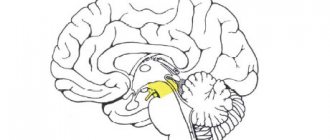General information
This part of the brain arose long before the front part became responsible for the functions of smell.
It consists of various parts of the entire analyzer, which is responsible for the functions of human senses. It is worth noting that the fish brain is almost entirely composed of ancient structure. But in humans, the limbic system, part of which is the olfactory brain, is responsible for these functions. It is localized at the junction of the inferior and medial surfaces of both hemispheres of the brain. If we consider its phylogenetic path of development, we can distinguish 3 main stages:
- Paleopallium, is one of the components of the temporal lobe of the cerebral cortex;
- Archipallium is located next to the so-called bulbus olfactorius area, covered with bark of old origin;
- Neopallium is a modern cloak; the highest centers of olfactory reflexes are formed in it - these are unique analyzers of the cortex.
Animals in ancient times used only this system to operate their olfactory functions. As we evolved, the olfactory brain became part of the limbic system, which is responsible for human sensory sensations.
Peculiarity
The olfactory organ is capable of influencing the thresholds of color perception, taste, hearing, and excitability of the vestibular apparatus. It is known that if a person’s sense of smell sharply decreases, then the pace of his thinking slows down. The structure of the olfactory organ is special; it distinguishes it from other senses. All structures of the olfactory analyzer take an important part in organizing emotions, behavioral reactions, memory processes, autonomic-visceral regulation, and regulation of the activity of other areas of the cerebral cortex.
There are substances that have a pungent odor (ammonia, vinegar essence). They are capable of exerting both an olfactory effect and an irritation on the sensory fibers of the trigeminal nerve. This explains the specificity of the formation of odor sensations. Respiration rate, pulse, and blood pressure can reflexively change under the influence of olfactory stimuli.
Structure
This part of the human brain consists of many structures.
Conventionally, it can be divided into two parts: peripheral and central. Let's look at the structure of each of them. The peripheral part is the olfactory lobe, it includes the bulb, tract and sulcus. The grooves have a triangle at their end, which in turn consists of 2 olfactory stripes:
- lateral, which bends around the lateral sulcus, its end is located in the temporal region;
- medial. It passes into the area of the subcallosal gyrus and the peri-olfactory field of the brain, which in turn are located in the area of the corpus callosum.
The central section consists of many cortical gyri: parahippocampal, dentate and vaulted. The latter has the shape of a ring; it is responsible not only for olfactory functions, but also for the functioning of all internal organs and systems. This gyrus is formed by the cingulate and parahippocampal regions, which are connected to each other by a special septum. The dentate gyrus is a small hook, it is directed towards the medial part of the brain. It also includes the hippocampus, fornix, and nuclei of the transparent part of the septum.
Two main parts create a unique system, it is responsible for the processes of smell. Most of them form the so-called limbic system. It was she who took over all the functions responsible for the human subconscious.
Olfactory brain (rhinencephalon) of the telencephalon (cerebrum)
The concept of the olfactory brain comes from old anatomical nomenclature. It is impossible to isolate such a section in the brain, since structures that are completely different both in origin and function have been artificially introduced into it. This name combines a number of structures that have long been mistakenly considered ancient formations that preceded the development of the human neocortex.
The olfactory part of the telencephalon is divided into peripheral and central parts.
The following structures belong to the peripheral part of the olfactory region (Fig. 65, Fig. 66):
The central part of the olfactory region is a very complex formation, which includes several main brain centers of the olfactory system. It includes:
The fornix is the conduction system of the olfactory brain. The arch is a strongly curved cord of white matter, almost entirely consisting of longitudinal fibers. It distinguishes between the body of the vault (corpus fornicis), the leg of the vault (crus fornicis) and the column of the vault (columna fornicis) (Fig. 67).
The body of the fornix is located under the corpus callosum. Its upper surface fuses with the lower edge of the septum pellucidum and with the lower surface of the corpus callosum. The inferolateral surface of the body of the fornix is freely adjacent to the thalami, but does not merge with them, since it is separated by oriented fibers.
Posterior section of the fornix - the right and left legs of the fornix are fused with the lower surface of the corpus callosum in front of its ridge. Behind the thalamus, the crura of the fornix diverge, bend laterally downward, and each of them forms part of the wall of the inferior horn of the lateral ventricle. Here each leg of the fornix ends, passing into the fimbria hippocampi.
The anterior sections of the fornix diverge somewhat laterally and pass into the columns of the fornix, which are located posterior to the anterior commissure and above the anterior sections of the thalamus. Each column, bending, goes down and plunges into the substance of the hypothalamus, where the columns diverge slightly. Further, each column of the fornix ends on the corresponding mastoid body of the hypothalamus.
The central and peripheral parts of the olfactory brain are interconnected and represent an integral system of primary and secondary centers that control the sense of smell.
Most of the structures of the olfactory brain (cingulate gyrus, dentate gyrus, hippocampus) are included in the limbic system.
The human brain is a complex system that allows each of us to fully move, eat and perform vital functions.
It is located in one of the sections of the skull, its bones create a kind of barrier, it helps protect the brain from injury.
A huge system of blood vessels approaches it; they transport nutrients and oxygen. The article will discuss the olfactory brain, its structure and main functions.
Structure functions
The main functions of the limbic system are:
- motivational processes. Development of certain needs, creation of functions for their implementation, assessment of the possibility of performing these actions, etc.;
- emotions. In this case, the structures in question are responsible for the formation of basic emotions in a person;
- memorization. This is one of the important points. This part of the brain is responsible for the so-called short-term memory function (it is created after a person’s full wakefulness cycle). further functioning is ensured by conservation of impulses;
- long-term memory;
- formation of higher centers of nervous regulation.
Among the emotions that originate in the olfactory brain are:
- feeling of fear. In this case, there is strong stimulation of the hypothalamus and tonsils;
- feeling of anger or complete calm;
- the feeling of pleasure or dependence on something is based on impulses passing through the brain's amygdala, nucleus accumbens and hippocampus.
Also, the olfactory brain, as a component of the limbic system, provides a person with functions responsible for sleep, appetite, sexual desire, memory, fear, etc.
If the functioning of one of its parts is disrupted, a person is diagnosed with serious pathologies.
Organ sensitivity
The acuity of smell can be judged by the fact that a person is able to clearly perceive, for example, the smell of 0.0000000005 parts of a gram of rose oil or musk, approximately 4.35 parts of a gram of mercaptan gas. If the air contains even 0.00000002 g per 1 cm3 of hydrogen sulfide gas, then it is clearly noticeable to us.
There are odors that are very powerful and persistent and can even be stored for 6-7 thousand years. An example of this is the smells experienced by people who participated in the excavations of the Egyptian pyramids. We can say that our nose is capable of detecting various impurities of odorous substances in very small quantities in the inhaled air, which cannot be measured even with the help of chemical studies.
The human olfactory organ is capable of distinguishing no more than several thousand different shades of odors. In this we are very far behind animals. Dogs, for example, can recognize about 500 thousand odors.
Pathologies
A neurologist treats problems associated with dysfunction of the olfactory brain. First of all, neurodegenerative processes should be attributed to pathological problems with this area. They cause serious disturbances in the hippothalamus, as a result of which the patient is diagnosed with Alzheimer's disease. Other diseases include:
- increased feeling of anxiety, which entails damage to the tonsils of the brain;
- epileptic seizures. They occur in both adult patients and children. In this case, partial sclerosis of the hippocampus occurs;
- depression;
- in case of disruption of the tonsils and some olfactory gyri, patients are diagnosed with autism or Asperger syndrome;
- the presence of malignant tumors that pinch the nerve endings in this area;
- problems with the functioning of the circulatory system, which are accompanied by insufficient nutrition of blood vessels in the area of the olfactory brain;
- schizophrenia;
- increased aggressiveness and excitability;
- congenital pathologies;
- impairment of olfactory functions, which may be accompanied by loss of taste, vision or smell.
In the latter case, the patient experiences a delay in the functions of transporting odors to the neuroepithelium in the olfactory area. They can occur against the background of chronic inflammatory or infectious processes, injuries, or exposure to chemical substances on the mucous membranes that can impair the function of the sense of smell.
To diagnose pathologies, MRI and CT examinations are used. They help to fully assess the state of all parts of the structure. Based on the research results, an effective treatment regimen is selected for the patient. For depression and increased excitability, tranquilizers and sedatives are used. Many disorders in the functioning of this area cannot be treated; the patient is given supportive therapy.
In older people, due to changes in this part of the brain, partial or complete memory loss occurs, tremors of the limbs occur, nerve cells die, etc. Unfortunately, such pathologies cannot be cured. In this case, the patient is constantly monitored by a specialized specialist.
The role of the olfactory organ
The organ of smell is the nose, which serves us so that we can enjoy wonderful smells and aromas.
It also warns us about various kinds of dangers (fire, gas leakage). A good sense of smell is very important for any person, since without it it is impossible to perceive the world 100%. So, with a poor sense of smell, life can become gray and dull, devoid of all colors. The organ of smell is a tool for obtaining information; it helps a person to understand the world. It is known that children whose perception of smells is impaired cannot develop properly and lag behind their peers. The human olfactory organ is closely related to the taste organ. A very small loss of the ability to subtly sense and distinguish smells negates the pleasure of the most delicious food. And people often choose their surroundings by smell. Probably no one will be able to communicate with a person for a long time if his aroma is not very pleasant.
The olfactory organ, helping us to perceive odors, is able to create mood and influence well-being. For example, cinnamon and mint scents can increase alertness and reduce irritability, while coffee and lemon scents can help promote clear thinking. The human olfactory organ has the ability to distinguish up to 10,000 aromas. This wealth given to us by nature must be treasured. None of the people wants to stop smelling flowers, herbs, forests, and the sea.








